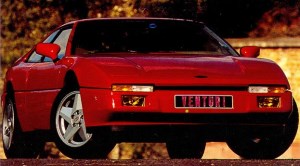
From Autocade
|
|
| (One intermediate revision by the same user not shown) | | Line 1: |
Line 1: |
| | [[File:MVS_Venturi.jpg]] | | [[File:MVS_Venturi.jpg]] |
| | | | |
| − | '''MVS Venturi/Venturi. 1987–2000 (prod. n/a). 2-door coupé, 2-door LWB coupé, 2-door coupé–cabriolet. M/R, 1995 cm³ (4 cyl. OHC), 2458, 2849, 2975 cm³ (V6 OHC).''' French sports’ car, the brainchild of Gérard Godfroy and Claude Poiraud. Attempted to be all-French product, including [[Peugeot]] four at development stage, before upgrading to [[Renault]] 2·5 V6 a year later, both developing 200 bhp thanks to turbocharging. Parts’ bin sourcing: [[Renault Fuego]] side glass, [[Citroën CX]] rear-view mirrors, [[Mercedes-Benz W201]] windscreen wiper, [[Renault 5 Turbo]] front indicators and [[BMW 3er-Reihe (E21)]] rear lights. First cars delivered 1987, but fell short of what [[Ferrari]] and [[Porsche]] could offer, with less performance. Harsh ride, poor handling, turbo lag. Transcup, a hardtop convertible, from 1988. Upgrade to 2·8 in 1989. MVS marque dropped in favour of Venturi in 1990. Stripped-down Atlantique 260 from 1991; 210 denoted detuned 2·8 turbo model. Four-cylinder for Italian market introduced 1991. Le Mans model commemorating entry into the race in 1993, while LWB 407 bhp Trophy for one-marque racing series introduced the same year with 3·0 twin-turbo V6. The 400 GT in 1994 was based on the Trophy, claiming fastest French production car title. | + | '''MVS Venturi/Venturi. 1987–2000 (prod. n/a). 2-door coupé, 2-door LWB coupé, 2-door coupé–cabriolet. M/R, 1995 cm³ (I4 OHC), 2458, 2849, 2975 cm³ (V6 OHC).''' French sports’ car, the brainchild of Gérard Godfroy and Claude Poiraud. Attempted to be all-French product, including [[Peugeot]] four at development stage, before upgrading to [[Renault]] 2·5 V6 a year later, both developing 200 bhp thanks to turbocharging. Parts’ bin sourcing: [[Renault Fuego]] side glass, [[Citroën CX]] rear-view mirrors, [[Mercedes-Benz W201]] windscreen wiper, [[Renault 5 Turbo]] front indicators and [[BMW 3er-Reihe (E21)]] rear lights. First cars delivered 1987, but fell short of what [[Ferrari]] and [[Porsche]] could offer, with less performance. Harsh ride, poor handling, turbo lag. Transcup, a hardtop convertible, from 1988. Upgrade to 2·8 in 1989. MVS marque dropped in favour of Venturi in 1990. Stripped-down Atlantique 260 from 1991; 210 denoted detuned 2·8 turbo model. Four-cylinder for Italian market introduced 1991. Le Mans model commemorating entry into the race in 1993, while LWB 407 bhp Trophy for one-marque racing series introduced the same year with 3·0 twin-turbo V6. The 400 GT in 1994 was based on the Trophy, claiming fastest French production car title. |
| | | | |
| | | | |
| − | ''Manufacturing locations:'' Cholet, Maine-et-Loire, France; Couëron, Nantes, France | + | ''Manufacturing locations:'' Cholet, Maine-et-Loire, France; Couëron, Nantes, France |
| | | | |
| | ''Marque:'' [[MVS]] | ''Successor:'' [[Venturi Atlantique 300]] | | ''Marque:'' [[MVS]] | ''Successor:'' [[Venturi Atlantique 300]] |
Latest revision as of 12:11, 23 November 2013

MVS Venturi/Venturi. 1987–2000 (prod. n/a). 2-door coupé, 2-door LWB coupé, 2-door coupé–cabriolet. M/R, 1995 cm³ (I4 OHC), 2458, 2849, 2975 cm³ (V6 OHC). French sports’ car, the brainchild of Gérard Godfroy and Claude Poiraud. Attempted to be all-French product, including Peugeot four at development stage, before upgrading to Renault 2·5 V6 a year later, both developing 200 bhp thanks to turbocharging. Parts’ bin sourcing: Renault Fuego side glass, Citroën CX rear-view mirrors, Mercedes-Benz W201 windscreen wiper, Renault 5 Turbo front indicators and BMW 3er-Reihe (E21) rear lights. First cars delivered 1987, but fell short of what Ferrari and Porsche could offer, with less performance. Harsh ride, poor handling, turbo lag. Transcup, a hardtop convertible, from 1988. Upgrade to 2·8 in 1989. MVS marque dropped in favour of Venturi in 1990. Stripped-down Atlantique 260 from 1991; 210 denoted detuned 2·8 turbo model. Four-cylinder for Italian market introduced 1991. Le Mans model commemorating entry into the race in 1993, while LWB 407 bhp Trophy for one-marque racing series introduced the same year with 3·0 twin-turbo V6. The 400 GT in 1994 was based on the Trophy, claiming fastest French production car title.
Manufacturing locations: Cholet, Maine-et-Loire, France; Couëron, Nantes, France
Marque: MVS | Successor: Venturi Atlantique 300
Search Carfolio for full specifications
|
|



